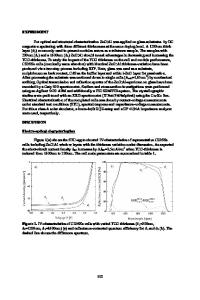The Study of the Optoelectronic Properties of a-SiGe:H Photodiodes
- PDF / 252,725 Bytes
- 5 Pages / 420.48 x 639 pts Page_size
- 0 Downloads / 306 Views
THE STUDY OF THE OPTOELECTRONIC PROPERTIES OF a-SiGe:H PHOTODIODES L.C. Kuo*, C.C. Lee**, [.H. Chen**, Y.K. Fang", C.H. Yu* * Materials Research Laboratories, Thin Film Technology Laboratory, Industrial Technology Research Institute ** National Chen Kung University, Department of Electrical Engineering ABSTRACT We have studied the spectrum of various types of a-SiGe:H alloys for pin and'Schottky barrier photodiodes, in which the band gaps of the a-SiGe:H vary between 1.75 eV and 1.35 eV. It has been found that the spectral reponse of the Schottky barrier diode shifts significantly to longer wavelength and the quantum efficiency decreases with an increase in I layer thickness. However, for the pin diode, an increase in the I layer thickness can hardly shift the spectrum to longer wavelength. For both pin and Schottky barrier diodes, the quantum efficiency can be increased by increasing the reverse bias. Therefore, an enhanced spectrum with a maximum at 800nm and a tall to lum can be achieved for a reverse-biased a-SiGe:H Schottky barrier diode. The results indicate that a-SiGe:H has a great potential for a low cost Infrared photodetector. INTRODUCTION The spectrum of un-alloyed a-Si:H photodetectors have been Investigated by several groups[I-3]. We have recently reported a-Si:H back to back Schottky diode for high speed color sensor[4]. The a-Si:H photodetector mainly appear in visible light region but not in infrared region. The a-SiGe:H alloy has attracted much attention due to its lower optical band gap which will give a better photoresponse at longer wavelength compared to a-Si:H film. A a-SiGe:H pin photodetector has been reported to be able to detect the light from a GaAs light source [5]. A a-SiGe:H Schottky barrier detector has been studied to detect the light pulse from a (AI,Ga) As laser diode[6]. In this paper,the optical bandgaps of a-SiGe:H films as I layers of photodiodes have been adjusted from 1.75 eV to 1.35 eV showing satisfactory electrical properties. We have studied the optoelectronic properties of a-SiGe:H pin diode and Schottky diode with various Ge content, I layer thickness and under different reverse biases. The advantage of such diodes is low- cost because these films are deposited at low temperature and can be over a large surface. EXPERIMENTAL The a-SiGe:H films and diodes have been prepared In a single chamber r.f. glow discharge CVD system. For the growths of a-SiGe:H films, SIH4 and GeH 4 have been used as the source gases and H2 as the diluent. The H flow rate and combined flow rate of SiH4 and Gelhhave been kept constant. Identical discharge conditions have been maintained at a system pressure of 0.3 torr, power density of 0.3 w/cmZ and a substrate temperature of 2501. The composition of the films have been controlled by changing the gas flow rate ratio, r=GeH4 /(Si1 4 +GeH4). The pin diode has a structure of glass/TCO/P type a-Si:H (300X)/a-SiGe:H (3000A-O11000X)/n type a-SI:H(300)/AI. The Schottky barrier diode has a structure of glass/TCO/n type a-Si:H(300A)/a-SiGe:H(3000 A-llOOO
Data Loading...









